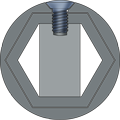
Axis Greenland style paddle GP1

The blade
Axis GP1 has generic Greenland style blades, developed with an eye on Gail Ferris' drawings of old paddles in museums and from ten years of experimenting with shapes and dimensions. The shape we eventually decided upon is one we believe would have been appreciated a hundred years ago on Greenland, but more importantly, one that has become our own favorite, and that has been enthusiastically reviewed by paddlers in kayak meetings and symposia.

An important feature is that the blade is narrow enough to be held comfortably anywhere – the Greenland paddle is often used extended or sliding. The GP1 blade width is 78 mm, which will suit most paddlers. A wider blade is no advantage even for very strong paddlers – properly used the blade is stable in the water regardless of the force applied. If you think you need a wider blade for speed, think again – or better, test with a GPS.
To prevent the blades collapsing under pressure the Axis paddle is fitted with a laminated vertical carbon wall – a lighter and structurally more efficient and elegant solution than the more common foam filled blades.

Another important feature is that the blade edges are thin all the way to the blade-shaft connection and that the tip is a half-circle. Other configurations may render the paddle no better than wings or euros when it comes to noise and water spouts. If on the other hand, the edges are too thin, the paddle is nice for racing but uncomfortable with sliding strokes and for rolling and bracing. There is a fine line, which takes experience to nail.
The shaft
A Greenland style shaft is slightly thicker than a standard paddle shaft. The result is a less tiring grip since the hand is more open and relaxed and the larger circumference means less pressure is required. The Axis shaft is slightly oval with more carbon fibers on the sides subjected to the largest bending forces, which means less overall weight for the necessary strength. This paddle is designed to be used for the full range of Greenland paddling and maneuvering strokes. The oval shape also lets the shaft position itself correctly in the hand – and with a blade stable in the water, the grip can be very relaxed regardless of weather conditions. Again less tiring...
The Axis shaft is slightly oval with more carbon fibers on the sides subjected to the largest bending forces, which means less overall weight for the necessary strength. This paddle is designed to be used for the full range of Greenland paddling and maneuvering strokes. The oval shape also lets the shaft position itself correctly in the hand – and with a blade stable in the water, the grip can be very relaxed regardless of weather conditions. Again less tiring...
Efficiency?
Many paddlers find it hard to accept that a Greenland paddle can challenge a high-tech wing or euro in speed and efficiency – accustomed as we are that hard work, vigorous arm movements, noise and waterspouts are the visual indicators of efficiency. And here is an odd looking several hundred years old device that is claimed to propel the kayak as efficiently as the modern high-tech wonders, but is silent in the water, requires less body movements and is less tiring. No wonder it may be hard to swallow. But try and you may be hooked! But remember that you have to change some of your habits. The stroke technique is slightly different from both wings and euros, and without it, you will not find the flow. Easy to learn for a beginner, but seasoned paddlers have to unlearn the sophisticated stroke motoric necessary for the extreme blades of racing paddles.
Dimensions
Blade width: 78mm
Total length: 180, 216, 219 and 222 cm
Approx weight (222 cm): 640 gr
The system
The Axis GP1 is not just one paddle – it is a system. Four different shaft pieces combine with the blades to suit the paddler, the kayak width and the paddling style. The joint is a hexagonal carbon fitting secured with a machine screw – a more stable and less obtrusive construction than the more common plastic clamp or sheet metal click button.

It also means that the GP1 can be used as a take-apart paddle for traveling – though requiring an Allen tool. It is not designed to be a two-piece spare on the aft deck. A short storm paddle (using the very short shaft) is a much better idea. Such a spare, 180 cm long, can be stored full-length on the foredeck and be in use within seconds should anything happen *.  Such a short paddle is used with sliding strokes and is thus in practice a full-length paddle, but with no part of the paddle exposed to the wind – hence the name storm paddle. The sliding stroke may take a while getting used to, but once mastered you will find it very useful.
Such a short paddle is used with sliding strokes and is thus in practice a full-length paddle, but with no part of the paddle exposed to the wind – hence the name storm paddle. The sliding stroke may take a while getting used to, but once mastered you will find it very useful.
GP1 is designed by Björn Thomasson, as are the kayaks, and on his website you will find a lot of info on how to get sparkling performance from your paddle.
* "Some years ago I broke a very light experimental paddle going over a breaking wave, and managed to get the storm paddle out for a high brace, almost before hitting the water"!(Björn Thomasson)
To buy a paddle, visit Kajakk & Fritid webshop – or call (32 83 27 10) or mail us (info@kajakk-fritid.no).
© Axis Kayaks | Design: Björn Thomasson